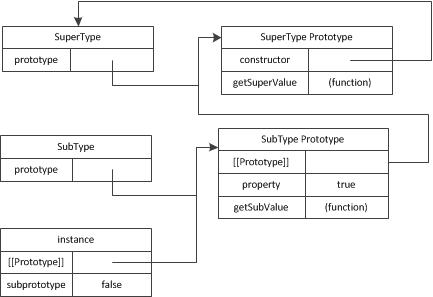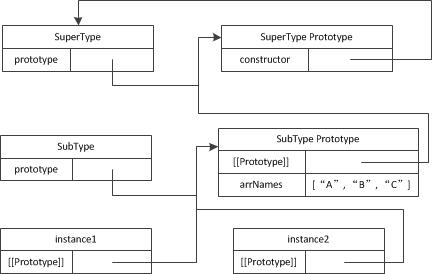第五节 继承-原型链、借用构造函数和组合继承
以下为实现原型链继承的基本模式,请画出该例中实例、构造函数及原型间的关系图(不需要画出Object Prototype)。
function SuperType(){ this.property = true; } SuperType.property.getSuperValue = function(){ return this.property; }; function SubType(){ this.subproperty = false; } SubType.prototype = new SuperType(); SubType.prototype.getSubValue = function(){ return this.subproperty; }; var instance = new SubType(); console.log(instance.getSuperValue); //true答:关系图如图所示。需要注意的地方是:
由于执行了SubType.prototype = new SuperType(),这时SubType.prototype实际上成为了SuperType()的一个实例。
因此,在SubType的prototype中会有指向SuperType Prototype的[[Prototype]]以及SuperType的属性property。
原型链继承中存在哪些问题?
答:在SuperType构造函数中定义的引用类型的属性(如this.arrNames=["A", "B", "C"]),会被SubType中的所有instance共享:
function SuperType(){ this.arrNames = ["A", "B", "C"]; } function SubType(){ } SubType.property = new SuperType(); var instance1 = new SubType(); instance1.arrNames.push("D"); console.log(instance1.arrNames); //"A", "B", "C", "D" var instance2 = new SubType(); console.log(instance2.arrNames); //"A", "B", "C", "D"原因如图所示,可以看到SubType中的arrNames实际上是SubType Prototype中的属性,instance1和instance2访问的实际上是同一个arrNames:

- 创建子类实例时,无法向超类型的构造函数中传递参数。
简述借用构造函数的思路?
答:在子类的构造函数中通过apply()/call()调用超类的构造函数,相当于让超类在子类中重新执行一次,使得子类具有超类的属性/方法。function SuperType(){ this.arrNames = ["A", "B", "C"]; } function SubType(){ SuperType.call(this); } var instance1 = new SubType(); instance1.arrNames.push("D"); console.log(instance1.arrNames); //"A", "B", "C", "D" var instance2 = new SubType(); console.log(instance2.arrNames); //"A", "B", "C"这样做的好处在于解决了原型链中的两个问题(见问题2)。
但是,这种方式存在一个问题,由于方法都定义在构造函数中,因此无法进行函数复用。
为此,可以采用组合继承的方式,组合原型链和借用构造函数的思路达到较好的继承效果。简述组合继承?
答:组合继承避免了原型链和借用构造函数的缺陷,融合了两者的优点,成为了JavaScript中最常用的继承模式。function SuperType(name){ this.name = name; this.colors = ["r", "g"]; } SuperType.property.sayName = function(){ console.log(this.name); }; function SubType(name, age){ SuperType.call(this, name); this.age = age; } SubType.prototype = new SuperType(); SubType.prototype.constructor = SubType; SubType.prototype.sayAge = function() { console.log(this.age); } var instasnce1 = new SubType("Nic", 21); instance1.colors.push("B"); console.log(instance1.colors); //"r", "g", "b" instance1.sayName(); //"Nic" instance1.sayAge(); //21 var instasnce1 = new SubType("Ali", 24); console.log(instance2.colors); //"r", "g" instance2.sayName(); //"Ali" instance2.sayAge(); //24